Planning a trip on one of the coastal voyages from Hurtigruten or Havila? Find out when the best time of year is to take the trip.
Cruising along the Norwegian coastline, stopping at small communities every few hours. Enjoying the best of Norwegian seafood and local food on board. There’s a lot to love about the “cruise that’s not a cruise” experience along Norway’s coastline.
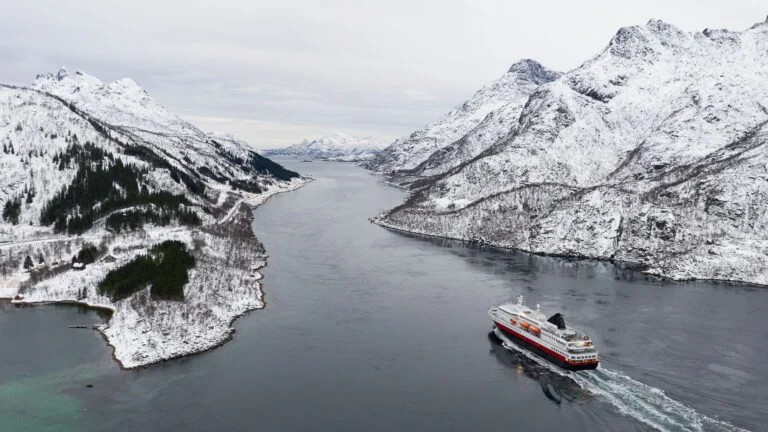
Many ships in the Hurtigruten fleet still sail along the coastline. But these days there are also a couple of new ships from Havila Voyages plying the historic route.
Choosing with line to sail with is a big decision. Whichever line you choose, that’s not your only decision. Another big one is when to sail.
When to sail on Hurtigruten coastal cruise?
There is a lot to bear in mind, from the weather and lighting conditions, the specific routes, and of course the price. Of course there’s no one best time for everyone, but there might be a best time for you.
I’ve taken the full Hurtigruten voyage once in January. You can read the diary of that voyage here. But I’ve taken shorter hops and spoken with many more people that have taken the voyage at other times of year. Here’s what everyone had to say!
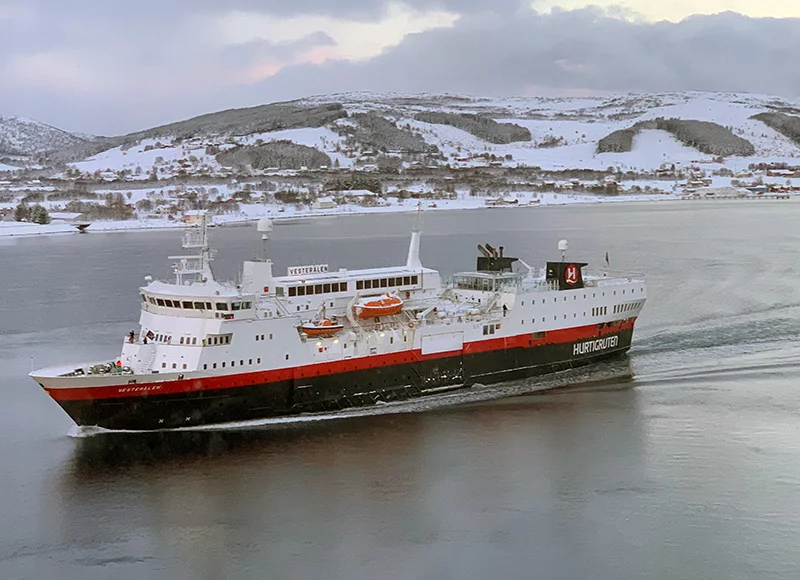
If you don’t mind crowds and paying a premium, the summer is a wonderful time to visit Norway. Chasing the northern lights in the winter is a popular activity. While the prices can be a little lower, it’s also much colder and darker, reducing what you’ll see during the daytime.
Shoulder seasons are where the best value lies. The ships will be quieter but there will be more uncertain weather. Now, let’s look at these factors in more detail.
Weather on the coastal voyage
Norway’s weather is notoriously changeable, but this is even more so along the Norwegian coastline.
Coastal temperatures tend to be milder than average. The coldest parts of Norway farther inland. However, coastal areas also receive more rain on average. It’s also impossible to give an average temperature for specific time as the route is so long.
Instead, it’s worth checking the average temperatures for at least Bergen, Trondheim, Bodø, Tromsø and Kirkenes for the time of year you are considering.
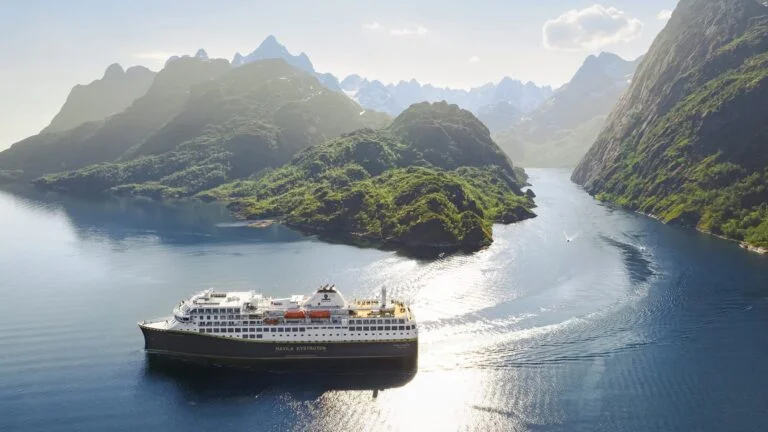
Consiering how quickly our climate is changing, you could also look at the specific temperatures for the last couple of years. Such weather data is relatively easy to find using services such as Yr.no.
Bear in mind that while sailing, the temperature is likely to feel cooler while on deck, especially if winds are high. Regardless of the time of year, you should expect at least some rain and wind.
Light conditions
This far north, the amount of daylight is an important consideration when picking a time of year. Daylight varies considerably throughout the year, especially north of the Arctic circle.
Midnight sun
In the summer, the midnight sun lights up the scenery all day. If you wake up at 1am, you can sit in a lounge and watch the landscape until you feel tired. Dates for the midnight sun are as follows:
- North Cape: 13 May – 30 July
- Hammerfest: 15 May – 29 July
- Vardø: 16 May – 28 July
- Tromsø: 19 May – 26 July
- Harstad: 23 May – 22 July
- Svolvær: 26 May – 18 July
- Bodø: 1 June – 13 July
Bear in mind these are the dates when the sun doesn’t set. For a few weeks either side of these dates, there will still be plenty of light at night.
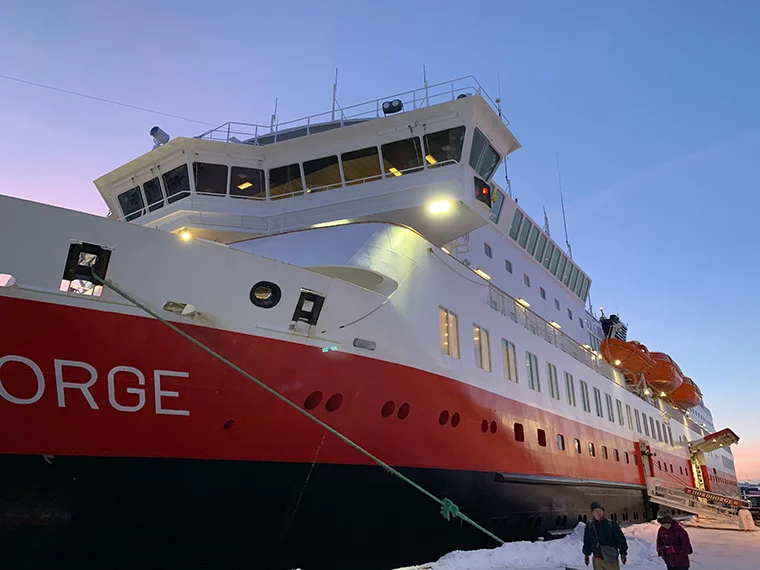
Polar nights
During the winter, the opposite is true. In polar nights, the sun doesn’t rise. You won’t experience complete darkness, but there will only be a few hours of twilight at best.
While this can lead to spectacular moonlit landscapes and of course the northern lights, it drastically reduces the amount of the lanscape you are going to be able to enjoy. The dates for polar nights are as follows:
- North Cape: 20 Nov – 22 Jan
- Hammerfest: 23 Nov – 20 Jan
- Vardø: 24 Nov – 18 Jan
- Tromsø: 28 Nov – 14 Jan
- Harstad: 3 Dec – 9 Jan
- Svolvær: 8 Dec – 5 Jan
- Bodø: No polar night
If you hope to see the northern lights, you’ll need clear skies. This is more common in the months before and after the polar nights. That’s why September-October and February-March are the most popular times for this.
That being said, spending days at sea in the north of Norway increases your chances drastically, as you will always be sailing towards different weather.
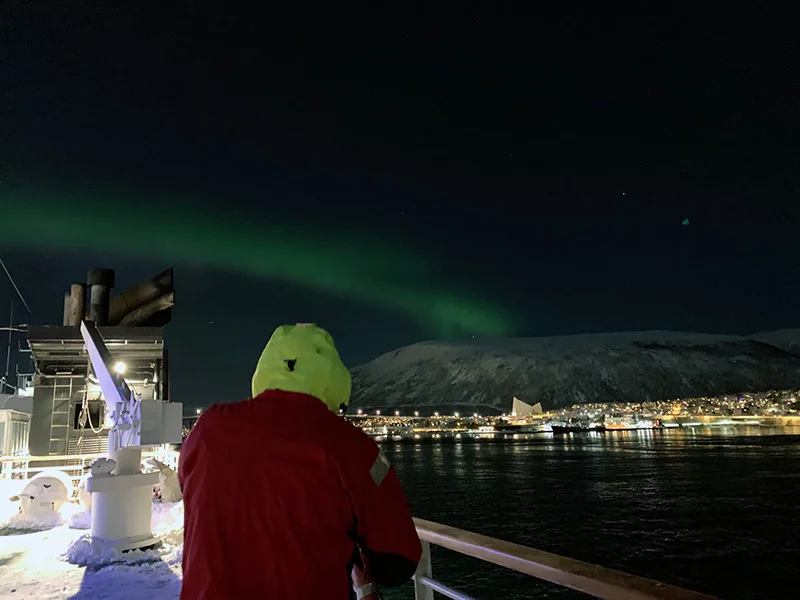
On my January voyage I saw the lights a couple of times, even though most days were cloudy. It had been a disappointing voyage from that perspective until the lights burst into life in Tromsø. Still, it was far from ideal conditions along much of the route.
Itinerary preference
A lesser-known fact about the coastal voyages is that the routes vary by season. During the summer, the vessels sail into the world-famous Geirangerfjord. During the autumn, the Hjørundfjord is added to itineraries.
Aside from visiting the Trollfjord in the north of Norway, this is the only chance you’ll get to see one of the famous Norwegian fjords on the route. So if this is important to you, it’s something to bear in mind.
During my January voyage, I asked the staff aboard the MS Vesterålen what time of year they would recommend for my next trip.
Without exception, the answer was the fall because of the lighting and autumnal colours. Because you’re sailing so far along the coastline, you’ll also likely expeirence the changing of the seasons from summer to fall or fall to winter as you sail north.
Prices
Last but certainly not least, the price. This will likely be the decisive factor for many people. Norway’s coastal voyage is not cheap at any time of the year.

However, prices really do soar from June to August. During the summer you can also expect the ships to be full with roundtrip guests and plenty of people using the ship as a local ferry too.
A summer trip will set you back at least NOK 25,000 per person compared with NOK 15,000 or even less during the less popular times of the year. Fares of NOK 40,000 are not uncommon at the busiest times.
During winter or some other quiet times, you’ll also find more special offers such as ‘no single supplement’ deals.
Prices also vary by ship. You can expect to pay a premium to be onboard the newest, flashiest ships. If you are looking for a bargain, consider the MS Vesterålen. Just be aware it is older and has less on offer than the newer ships.
What’s your preferred time to take the coastal cruise, and why? Perhaps you have some advice for people considering a voyage with Huritgruten or Havila? Let us know in the comments below.


How close to shore do these ships go. My wife can be sea sick when the winds blows and waves are high.
Mostly close to the coastline and between islands etc, but there are a few sections of open sea particularly on the west cape and in the north.